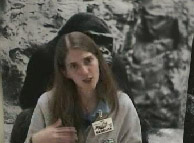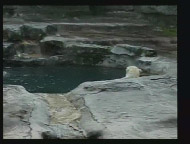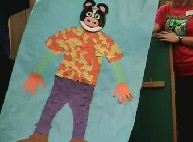 Today we have nine classes participating in our first ASK program of the year, on the book Ice Bear and Little Fox. Students have read the book, journaled, and written great questions, following the ASK process. Four of the classes are from Region 12, TX, as we are mentoring Region 12 in doing their own ASK programs too.
Today we have nine classes participating in our first ASK program of the year, on the book Ice Bear and Little Fox. Students have read the book, journaled, and written great questions, following the ASK process. Four of the classes are from Region 12, TX, as we are mentoring Region 12 in doing their own ASK programs too.
Students are interviewing Rebecca Balk, at the Buffalo Zoo. This is our first  year using the Buffalo Zoo for this program and we are delighted with the results. Rebecca is weaving into her answers extra visuals and items to show the students, related to the questions they are asking. She is also great at really quick answers for young attention spans. Sometimes we keep track of how many questions we get in an ASK program, and in the first session this morning, Rebecca answered 32 questions in 45 minutes. Which is quite a record! Since the ASK program is question based and students spend so much time preparing their questions, we sure appreciate authors and specialists who can give concise interesting answers.
year using the Buffalo Zoo for this program and we are delighted with the results. Rebecca is weaving into her answers extra visuals and items to show the students, related to the questions they are asking. She is also great at really quick answers for young attention spans. Sometimes we keep track of how many questions we get in an ASK program, and in the first session this morning, Rebecca answered 32 questions in 45 minutes. Which is quite a record! Since the ASK program is question based and students spend so much time preparing their questions, we sure appreciate authors and specialists who can give concise interesting answers.
Here are some examples of the students’ questions:
 How long is the mother polar bear pregnant with a baby polar bear?
How long is the mother polar bear pregnant with a baby polar bear?- Does the polar bear have bones in it’s body that humans don’t have?
- How deep can a seal dive?
- How long do polar bears live?
- What do killer whales weight?
- What is your favorite thing about polar bears?
- How many polar bears are left in the world?
- Do walruses attack polar bears?
- Do polar bears hunt foxes?
If you’re thinking about starting an ASK program, this is a really easy one to start with. Rebecca knows how ASK works; her sessions are reasonably priced; and your schools probably already have the book! So you’d just need to share with your teachers the ASK training materials – linked at the top of the TWICE ASK page.



 Today we have nine classes participating in our
Today we have nine classes participating in our  year using the Buffalo Zoo for this program and we are delighted with the results. Rebecca is weaving into her answers extra visuals and items to show the students, related to the questions they are asking. She is also great at really quick answers for young attention spans. Sometimes we keep track of how many questions we get in an ASK program, and in the first session this morning, Rebecca answered 32 questions in 45 minutes. Which is quite a record! Since the ASK program is question based and students spend so much time preparing their questions, we sure appreciate authors and specialists who can give concise interesting answers.
year using the Buffalo Zoo for this program and we are delighted with the results. Rebecca is weaving into her answers extra visuals and items to show the students, related to the questions they are asking. She is also great at really quick answers for young attention spans. Sometimes we keep track of how many questions we get in an ASK program, and in the first session this morning, Rebecca answered 32 questions in 45 minutes. Which is quite a record! Since the ASK program is question based and students spend so much time preparing their questions, we sure appreciate authors and specialists who can give concise interesting answers. How long is the mother polar bear pregnant with a baby polar bear?
How long is the mother polar bear pregnant with a baby polar bear? Are you still thinking of how you can get to Elevate 2008 Conference, August 24-27 in Banff, Alberta, Canada next year? This will inspire you. Check out the
Are you still thinking of how you can get to Elevate 2008 Conference, August 24-27 in Banff, Alberta, Canada next year? This will inspire you. Check out the  So, when you did your fall shopping this year, did you look for “videoconferencing clothes?” It struck me funny this year how much videoconferencing has affected my life; down to the choice of clothing.
So, when you did your fall shopping this year, did you look for “videoconferencing clothes?” It struck me funny this year how much videoconferencing has affected my life; down to the choice of clothing.